Sound & Vision
Bristol, February 22-24, 2004
Part II
Author: Werner Ogiers

|
|
|
Ever since their takeover by a Scandinavian group do Tannoy display a technological vitality that might well turn them into a new B&W. Fifteen years after Meridian pioneered the concept is there now a new range of digitally-enabled loudspeakers: Tannoy Eyris iDP. Strikingly similar to the ordinary Eyris range, the iDPs each contain a digital interface, digital equalizer/preamp, DACs and power amplifiers, requiring only a single digital source to be turned into a complete music or home theater system. iDP also includes digital room equalization, if I understood correctly this is to be set up by the dealer at installation time, all controlled from a PC running dedicated Tannoy software. |
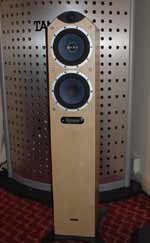 |
|
iDP also includes two active subwoofer. But there was more. How about a whole new entry-level range, named Fusion? These start at a mere 90UKP/pair for the tiny Fusion R rear speakers that still are good enough to be used as a stereo pair, up to the 350 UKP for the Fusion 4 twin-woofer floorstander. Other additions to the portfolio were two in-wall speakers, one with dual-concentric technology, and the Tannoy book, signed at the show by the founder's son, Michael Fountain, and by the author, Julian Anderton. |
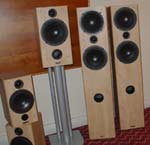
|
|
| |
|
As usual Meridian organised closed-doors timed demonstrations, obviously with the intent of educating the audience on Meridian's latest as well as on the concepts of DVD-Audio (hey, there was a hybrid DVD-A disc playing!). Sadly, and also as usual, this missed the mark somewhat due to a bland selection of demo muzak. Oh well. Lately Meridian replaced the entire 500-series with the new G-components, truly a massive change in their programme. The G-range contains the usual suspects as well as one highly-integrated component that packs a CD-player, a digital volume control, a DAC, and a preamp with analogue and digital inputs (and hence ADCs). This box, combined with a pair of Meridian's digital speakers (or Tannoy's? Sorry, couldn't resist) makes a complete system.
In the neighbouring room Chord added the Mezzo 50 and Mezzo 140 stereo power amplifiers to their stylish Choral mini system (50W, 1900 UKP and 140W, 3250 UKP respectively). |
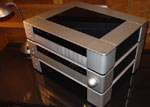 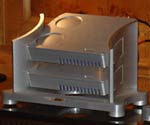
|
|
| |
|
Mission followed their Pilastro flagship loudspeaker with a derivative and much cheaper speaker line, the Elegante. This range comprises three complete 6.1-channel systems, priced from UKP 2800 to 4800, and as such taking position at the company's (still-affordable) top of the range.
Arcam has been steadily increasing its catalogue of audio electronics, with more and more emphasis on home theatre solutions at the higher side of the market. This show saw the launch of a fatter 7.1-channel receiver in the DiVA series, the AVR-300. The performance-driven Full Metal Jacket series is extended with the C30-7.1, a fully analogue preamplifier with 7.1 channel capability as well as an in-built MM/MC phonostage (UKP 1500). Arcam suggest to use this pre with two or seven of their new UKP 1100 balanced-input P-1 power amplifiers. | 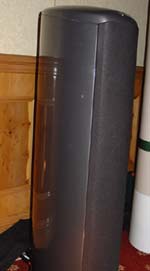 |
| If you know my admiration for Myryad's entry-level Z-series, then you'll understand that I find their succession of the M-series with the new MX-series a major event. MX encompasses a tuner, CD-player, stereo preamp, and two integrateds for the audio-minded, but also a surround preamp/processor, a DVD-player, and set of stereo and modular power amplifiers for AV-solutions, the fully-loaded one good for 7 x 150W or 14 x 80W. Sad then that the MXV3000 DVD is video-only, instead of a universal disc player. A missed chance? | 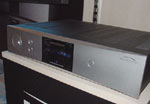 |
| Some other bits: Inca Design showed the intrigueing Katana CD-player (inspired by 'Kill Bill'?). From Anthony Gallo there was the upmarket Reference III speaker, combining the well-known balls and expanding leaf tweeter with a serious woofer. JMLab gave acte the presence with their new Utopia Diva Be, a slimline floorstander with beryllium tweeter and side-firing woofer. Wilson-Benesch unveiled the Curve high-end loudspeakers, borrowing heavily from their top model the A.C.T., and finally Leema Acoustics had a cute 250W active sub with extensive crossover options. |
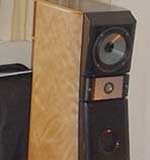
|
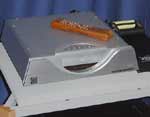
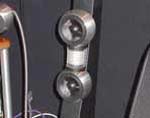
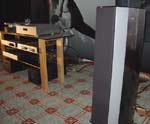
| 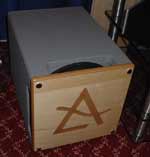 |
|
| |
|
Iconoclasts O'Heocha had their usual display of weird and wonderful loudspeaker creatures, but this time the whole caboodle was not connected. I mean, all were playing ... wireless. With transmitters and receivers positioned at the preamp and at the power amps driving the active speakers.
Even though I don't care about this particular setup, this still is interesting. You know that I am a proponent for multichannel music listening, for the very simple reason that it would liberate our systems from the strict confines of stereo (if you think stereo is really 3D then think again). But I am also realist enough to understand that multi won't ever really happen, not unless it is made easy, with the additional channels requiring no modifications to the room such as inconveniently long wire runs. Hence my desire for a simple, transparent wireless solution that can turn a preamp output into power at a remote speaker. | 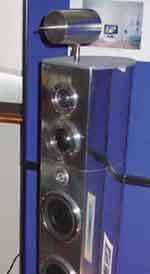 |
|
| |
|
More wireless could be found at Cyrus, albeit in a different fashion. The Cyruslink multiroom system consists of the Linkserver box acting as a CD-player-cum-harddisk musicserver, including on-screen user interface (connect a plasma) and boasting audiophile-quality Cyrus-style DACs and analogue stages so that the thing can indeed act as a worthy source of CD in any system. The HD can contain MP3s as well as raw music files.
At remote positions, connected by ethernet or wirelessly, Linkport music centres are to be used. These are small self-contained boxes containing 2x15W amplification, FM tuner, and a link to Linkserver and even to internet. The whole is controlled through Linkwand software running on a number of industry-standard PDAs. |
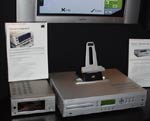 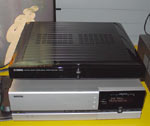
|
|
Yahama offered its similar MusiCast wireless system with central 80GB server, including a CD writer, and local clients. The clients each include a digital stereo power amplifier, and matching flat loudspeakers are optionally available.
Also new from Yahama was the 500W (!) MX-D1 digital stereo power amplifier at UKP 3000 and for once not based on a third-party off-the-shelf chip set. | 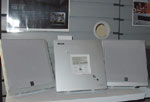 |
|
| |
|
Onkyo had the A1 dual-mono integrated amplifier, a refreshingly purist thing with only two knobs, and the matching C1 CD-player with Wolfson WM8740 DAC chip. Also on display were the top-of-the-line DS-VP1000E DVD-A player with HDMI interface, and also-equipped TX-NR1000 AV-receiver.
Sony demonstrated the digital 9000 Series multichannel amplifier connected with iLink to an SACD player. | 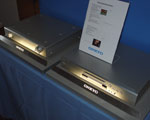 |
| From TEAC there was of course the august DV-50 universal disc player, at the top end, and at the bottom an amusing collection of table-top CD-radio systems, some pathetically retro, some outright desirable. Further there was a tiny and thin music centre with a CD-receiver and NXT-based loudspeakers. Hey, do you remember that wonderful Technics hang-off-the-wall system from the eighties? | 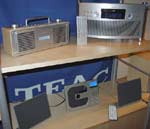 |
| Tivoli showed a working prototype of the Model DAB. You guessed it: a Digital Audio Broadcasting version of the celebrated Model One table radio. Still in its infancy, production should hit the market before the end of this year, at the not unreasonable price of UKP 200. Tivoli also had a faux-leather black carrying case for the PAL radio that made it look more than a little bit like a Rolleiflex. | 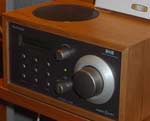 |
|
| |
| ArchDABlers Pure brought with the Legato a compact remote-controlled micro system encompassing a DAB/FM tuner, CD-player, and two loudspeakers, each with a couple of 3" wideband drivers. The DAB section employs Pure's Digital Psycho-Acoustic Compensation-II processing: some sort of loudness if you ask me, necessary to make the sound of DAB more listenable, no less. At the other side of the spectrum was the PocketDAB 1000 walkradio: 160 grammes and 18 hours of battery autonomy. |  |
|
| |
| Denon demonstrated how small a 'serious' home theatre could be. After their critically-acclaimed 210 mm-wide UD-M31 receiver-with-CD-player, they pulled of the very same trick with the new ADV-M71 DVD-receiver: two channels of power (35W), a tuner section, a DVD-player, and a 'surround' processor transcoding Dolby Digital and DTS into Dolby Virtual Speaker. Add a 2.1 speaker system like the SYS-A2.1Ls and a screen (preferrably a plasma on the wall) and you're set. Admit it: the ideal bedroom system! | 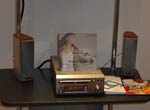 |
|
| |
| KEF did something similar with their cute KIT - KEF Instant Theatre: a central control unit houses a DVD-player and receiver with Dolby Digital and DTS, again virtualised to two channels. A separate woofer coffin with amplifiers provides the welly, driving, and this is the clever bit, a pair of front speakers each worth two channels of information: a Uni-Q coaxial two-way for the front channels proper, and side-firing NXT panels for the surrounds, Niro-style reflecting off the side walls. |  |
|
| |
|
Tube Technology demonstrated their complete and rather massive valve system, now with the new Genetix monoblocks. If Chord were ever to make vacuum-electronics it would probably look exactly like this.
If you want to add AV-multi to an existing system, or at least the DVD you already own, then Acoustic Energy's new AEGO Series P5-II may be the ticket: a small decoder with amplifiers married to five of AE's tiny satellites and a woofbox.
| 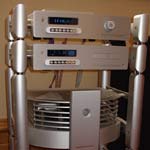 |
| More seriously, AE also took the opportunity to launch the mid-fi (their nomination, not mine) Aelite speaker line, comprising of the Aelite 2 two-way two-woofer standmount and the Aelite 3 three-way column model, both with metal-alloy bass and mid drivers. The range is to be completed in 2004 with additional center and surround speakers and a subwoofer. | 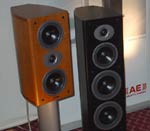 |
© Copyright 2004 Werner Ogiers - www.tnt-audio.com